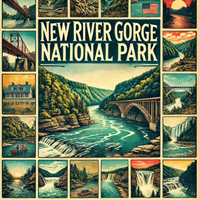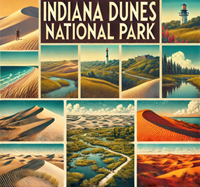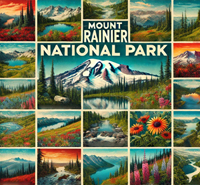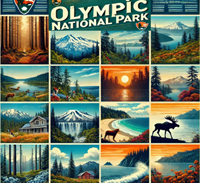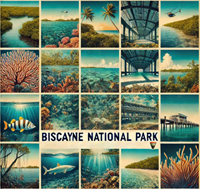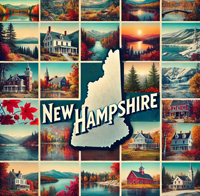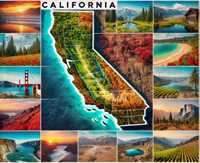

William and Hui Cha Stanek have meticulously crafted these national park guides, each showcasing the most stunning landscapes across the USA. But beyond the breathtaking scenery, these guides delve into the stories, experiences, and connections that make each park visit truly memorable.
National Parks Index | US Itineraries Index | American Roadtrips Index

Bring home a Bugville Critters book and watch as your child's love for reading and learning grows with every page. Hand-painted illustrations bring the heartwarming stories to life. Ask your librarian to add Bugville Critters to the library's digital collection today!
Discover William Stanek's Exclusive Art Collection
Explore and purchase the stunning art featured on this site. Own a piece of William Stanek's unique and captivating artwork today!
(May 2, 2025) Introducing Lake Clark National Park and Preserve: Alaska's Pristine Wilderness
Introduction to Lake Clark National Park and Preserve
Lake Clark National Park is a place where the natural beauty of Alaska is on full display, from the towering peaks of the Chigmit Mountains to the crystal-clear waters of Lake Clark itself. The journey to the park, accessible only by boat or plane, adds to the sense of adventure and remoteness that defines Lake Clark. One of my most cherished memories is watching the sunset over the lake, with the sky ablaze in shades of orange and pink, reflected perfectly in the still waters. The park' s diverse landscapes offer endless opportunities for exploration, from hiking through the tundra to spotting bears fishing in the rivers. Lake Clark is a place of peace and solitude, where the beauty of the Alaskan wilderness feels both vast and intimate.
How to Reach Lake Clark National Park and Preserve
From the North (Anchorage, AK): Travelers can take a flight from Anchorage to Port Alsworth, the gateway to the park. The flight takes approximately 1 hour.
From the South (Homer, AK): Visitors from Homer can take a flight to Port Alsworth. The total travel time is approximately 1.5 hours.
From the East (Dillingham, AK): From Dillingham, travelers can take a flight to Port Alsworth. This journey spans approximately 1 hour.
From the West (Kodiak, AK): Travelers from Kodiak can take a flight to Port Alsworth. This route covers approximately 2 hours.
Exploring Lake Clark: Must-Visit Sites
- Lake Clark: The park's namesake, offering stunning views, fishing, and kayaking opportunities.
- Tanalian Falls: A beautiful waterfall accessible via a hiking trail from Port Alsworth.
- Turquoise Lake: Known for its vivid blue waters and scenic surroundings.
- Twin Lakes: Famous for its historic cabins built by Richard Proenneke, offering a glimpse into wilderness living.
Seasonal Variations
Lake Clark's remote wilderness offers unique beauty in each season:
- Spring: Melting snow and ice create waterfalls and lush green landscapes, with fewer visitors.
- Summer: Long daylight hours and milder temperatures make for ideal hiking, fishing, and wildlife viewing conditions.
- Fall: Cooler temperatures and vibrant fall foliage provide a stunning contrast to the rugged landscapes.
- Winter: Snow-covered landscapes offer a serene and stark beauty, ideal for solitude and winter sports.
Visitor Updates for Lake Clark National Park
Conservation Efforts
William Stanek's photography in Lake Clark emphasizes the park's pristine wilderness and the importance of preserving its unique ecosystems. His work supports efforts to protect the park from the impacts of climate change, human activity, and wildlife disturbances, advocating for the conservation of its natural beauty and biodiversity.
1 Day at Lake Clark National Park and Preserve: Alaska's Remote Wilderness
Introduction
Lake Clark National Park and Preserve, located in southern Alaska, is known for its stunning landscapes, including glaciers, volcanoes, and pristine lakes. Here's a detailed guide to making the most of your visit, with expert tips from William and Hui Cha Stanek.
Morning: Arrival and Lake Exploration
7:00 AM - Breakfast in Anchorage
- Overview: Start your day with a hearty breakfast in Anchorage, Alaska, before flying to Lake Clark National Park.
- Tips from William: Capture the morning light on the city's streets and surrounding mountains.
- Insights from Hui Cha: Enjoy a nutritious breakfast to fuel your day. Pick up some snacks and water for later.
8:00 AM - Flight to Port Alsworth
- Overview: Take a scenic flight from Anchorage to Port Alsworth, the main gateway to Lake Clark National Park.
- Tips from William: Use a wide-angle lens to capture the aerial views of the rugged landscape and pristine lakes. The flight provides excellent photo opportunities.
- Insights from Hui Cha: Dress warmly and bring a rain jacket. The weather can be unpredictable and chilly.
Mid-Morning: Lake and Trail Exploration
10:00 AM - Lake Clark
- Overview: Explore Lake Clark, known for its clear waters, surrounding mountains, and abundant wildlife.
- Tips from William: Use a wide-angle lens to capture the stunning views of the lake and its reflections. The morning light is perfect for photography.
- Insights from Hui Cha: Wear comfortable shoes and bring water. The area offers great opportunities for short hikes and exploration.
12:00 PM - Picnic Lunch at Tanalian Falls
- Overview: Enjoy a packed lunch at Tanalian Falls, a beautiful spot with views of the waterfall and surrounding forest.
- Tips from William: Capture candid moments of your picnic with the stunning waterfall backdrop.
- Insights from Hui Cha: Pack a nutritious and energizing meal. Take a moment to relax and enjoy the natural surroundings.
Afternoon: Hiking and Wildlife Viewing
1:30 PM - Tanalian Falls Trail
- Overview: Hike the Tanalian Falls Trail, which offers views of the falls, forest, and potential wildlife sightings.
- Tips from William: Use a wide-angle lens to capture the dramatic landscape and lush vegetation. The afternoon light enhances the colors and textures.
- Insights from Hui Cha: The trail is moderately strenuous, so wear sturdy hiking shoes and bring plenty of water. The views are worth the effort.
3:00 PM - Twin Lakes
- Overview: Visit Twin Lakes, known for their pristine waters and stunning mountain views.
- Tips from William: Use a wide-angle lens to capture the expansive views of the lakes and mountains. Late afternoon light is ideal for photography.
- Insights from Hui Cha: The area is rich in wildlife, so bring binoculars and be patient. Enjoy the peaceful surroundings and take your time.
Late Afternoon: Photography and Relaxation
4:30 PM - Chinitna Bay
- Overview: Explore Chinitna Bay, known for its tidal flats, wildlife, and views of the surrounding mountains.
- Tips from William: Use a telephoto lens to capture the wildlife and distant views of the mountains. Experiment with different compositions and perspectives.
- Insights from Hui Cha: This is a perfect spot to relax and take in the scenery. Bring a snack and enjoy the view.
Evening: Sunset and Return
6:00 PM - Sunset at Crescent Lake
- Overview: Head to Crescent Lake for a stunning sunset view over the lake and surrounding landscape.
- Tips from William: Use a graduated neutral density filter to balance the exposure. Experiment with long exposures to capture the changing light.
- Insights from Hui Cha: Arrive early to find a good spot. Bring a light jacket as it can get cool after sunset.
7:30 PM - Flight Back to Anchorage
- Overview: Take the flight back to Anchorage, enjoying the peaceful evening ride.
- Tips from William: Capture the evening light on the rugged landscape and surrounding wilderness. Use a telephoto lens for detailed shots.
- Insights from Hui Cha: Reflect on the day's adventures and enjoy the serene ride back. Keep an eye out for wildlife from the plane.
Lake Clark National Park and Preserve (Alaska)
Lake Clark National Park and Preserve, located in southwestern Alaska, is known for its stunning landscapes, including rugged mountains, pristine lakes, and active volcanoes. Covering over 4 million acres, the park offers unparalleled opportunities for wilderness adventures, such as hiking, fishing, and bear viewing, making it a remote and pristine destination for nature enthusiasts.
Park History and Cultural Significance:
- Established as a national park and preserve in 1980, Lake Clark protects significant natural and cultural resources, including active volcanoes and rich ecosystems.
- The area has a rich history of Native Alaskan habitation, particularly by the Dena'ina people. The park also preserves sites related to early European explorers and settlers.
Visitor Centers and Facilities:
- Port Alsworth Visitor Center: Offers exhibits on the park's natural and cultural history, maps, information, restrooms, and a gift shop.
- Campgrounds: There are no developed campgrounds within the park, but backcountry camping is available.
Best Times to Visit:
- Summer (June to September): The best time to visit with long daylight hours, moderate temperatures, and accessible trails and roads.
- Fall (October to November): Cooler temperatures and fewer crowds, but weather can be unpredictable.
- Winter (December to March): Offers solitude and opportunities for winter activities like snowshoeing and cross-country skiing, but temperatures can be extremely cold.
- Spring (April to May): Snow begins to melt, but access can be challenging due to muddy conditions and melting ice.
Activities and Recreation:
- Hiking and Backpacking: The park offers vast wilderness for backcountry hiking and exploration, with no designated trails.
- Wildlife Watching: Opportunities to see brown bears, moose, caribou, and a variety of bird species.
- Fishing: The park's rivers and lakes offer excellent fishing opportunities, particularly for salmon and trout.
- Boating and Kayaking: Explore the park's coastal waters and lakes by boat or kayak.
- Photography: The park's dramatic landscapes and abundant wildlife provide endless opportunities for photography, particularly at sunrise and sunset.
- Flightseeing: Scenic flights offer breathtaking views of the park's vast landscapes, including volcanoes, glaciers, and lakes.
- Camping: Backcountry camping provides opportunities for a true wilderness experience.
- Ranger-Led Programs: Participate in educational programs and guided tours to learn about the park's natural and cultural history.
Accessibility Information:
- The Port Alsworth Visitor Center is wheelchair accessible.
- Access to the park's remote areas can be challenging for those with mobility issues due to the rugged terrain and limited facilities.
- Accessible restrooms are available at the visitor center.
Permits and Regulations:
- Entrance Fees: There are no entrance fees for Lake Clark National Park and Preserve.
- Camping Permits: Not required for backcountry camping, but visitors are encouraged to register their trip.
- Backcountry Permits: Not required, but it is recommended to register your trip at the visitor center.
- Fishing Permits: Required for fishing in the park's rivers and lakes.
- Special Use Permits: Needed for activities such as commercial filming and large group gatherings.
Nearby: Chugach National Forest, Kenai National Wildlife Refuge
-
Chugach National Forest: About two hours from Lake Clark, this forest offers extensive outdoor activities and diverse landscapes.
- Activities: Hiking, fishing, camping, wildlife viewing.
- Notable Sites: Portage Glacier, Spencer Glacier.
- Wildlife: Black bears, mountain goats, various bird species.
-
Kenai National Wildlife Refuge: Located about two hours from Lake Clark, this refuge features diverse wildlife, lakes, and rivers, offering opportunities for fishing and hiking.
- Activities: Fishing, hiking, wildlife viewing.
- Notable Sites: Skilak Lake, Kenai River.
- Wildlife: Moose, brown bears, bald eagles.
Important Updates for Lake Clark National Park
Lake Clark National Park and Preserve (Alaska)
Local Attractions and Surrounding Areas:
Lake Clark National Park and Preserve is a remote wilderness area in southwestern Alaska, offering stunning landscapes and abundant wildlife. The nearest gateway to the park is the small community of Port Alsworth, which serves as the primary access point for visitors. Port Alsworth provides essential amenities, including lodging, dining, and guided tours.
For those seeking a broader Alaskan adventure, the city of Anchorage is the closest major city, offering a wide range of attractions and amenities. Anchorage is known for its vibrant cultural scene, with museums, galleries, and cultural centers showcasing the history and heritage of Alaska. The Alaska Native Heritage Center is a must-visit, offering exhibits and performances that celebrate the diverse cultures of Alaska's indigenous peoples.
Another nearby attraction is the Kenai Peninsula, known for its stunning coastal scenery, rich wildlife, and outdoor recreation opportunities. Visitors can explore the charming towns of Homer and Seward, each offering unique experiences and access to some of Alaska's most beautiful landscapes.
Lake Clark offers a diverse landscape of volcanoes, glaciers, and tundra, requiring careful planning.
- Weather: Can change rapidly, with rain, cold, and high winds common. Be prepared for all weather conditions.
- Wildlife: Bears and other wildlife are prevalent. Carry bear spray and follow all safety guidelines.
- Terrain: Rugged and challenging. Limited trails require proficiency with navigation tools.
- Isolation: Remote with limited access. Be self-sufficient and prepared for emergencies.
- Permits: Required for overnight backcountry camping.
Nearby Attractions
Lake Clark National Park is surrounded by numerous attractions that enhance the visitor experience. Here are some must-see local attractions:
-
Lake Clark: The park's namesake, Lake Clark is a large, pristine lake offering opportunities for boating, fishing, kayaking, and wildlife viewing. The lake is surrounded by stunning mountain scenery.
-
Port Alsworth: The main access point to the park, this small community offers lodging, guided tours, and access to nearby trails and lakes.
-
Twin Lakes: Known for their clear waters and scenic beauty, the Twin Lakes area offers excellent opportunities for fishing, kayaking, and hiking. The site also features the historic cabin of famed naturalist Richard Proenneke.
-
Tanalian Falls: Located near Port Alsworth, Tanalian Falls is a powerful waterfall offering stunning views and excellent photography opportunities.
-
Turquoise Lake: Accessible via a challenging hike, Turquoise Lake offers breathtaking views of its vibrant blue waters surrounded by rugged mountains.
-
Mount Iliamna and Mount Redoubt: These active volcanoes provide a dramatic backdrop to the park's landscape and offer unique opportunities for photography and exploration.
Nearby Towns and Cities
Visitors to Lake Clark National Park can find additional amenities and activities in nearby towns and cities:
-
Anchorage, Alaska: The primary gateway to Lake Clark, Anchorage offers extensive amenities, including hotels, restaurants, shopping, and attractions such as the Alaska Native Heritage Center and the Anchorage Museum. Flights and boat charters to the park typically depart from Anchorage.
-
Homer, Alaska: Located on the Kenai Peninsula, Homer offers a charming harbor, art galleries, and attractions such as the Homer Spit and the Pratt Museum. It's also a base for flights and boat charters to Lake Clark.
-
Kenai, Alaska: Located about 100 miles southwest of Anchorage, Kenai offers accommodations, dining, and access to outdoor activities such as fishing and wildlife viewing. Flights to Lake Clark are available from Kenai.
-
Soldotna, Alaska: Located near Kenai, Soldotna offers additional amenities and is a popular destination for fishing on the Kenai River. Flights to Lake Clark can also be arranged from Soldotna.
Scenic Drives
Due to the remote nature of Lake Clark National Park, scenic drives within the park are not possible. However, the journey to the park via air or boat offers breathtaking views of Alaska's rugged landscapes.
- Lake Clark Pass Scenic Flight: While not a traditional scenic drive, the flight into Lake Clark National Park offers one of the most breathtaking aerial views in Alaska. The flight takes visitors over the rugged mountains and expansive wilderness of the park, providing stunning views of glaciers, lakes, and volcanoes. William and Hui Cha both highlight this flight as an essential part of the Lake Clark experience, offering unparalleled photographic opportunities.
Additionally, here are some scenic drives in the nearby areas that provide beautiful vistas and enhance the overall experience:
-
Seward Highway (Anchorage to Seward):
- Details: This 127-mile scenic drive connects Anchorage to Seward, offering stunning views of the Chugach Mountains, Turnagain Arm, and Kenai Peninsula.
- Key Stops: Highlights include Beluga Point, Bird Point, Girdwood, Portage Glacier, and the Kenai Lake Overlook.
- Photography Tips: William Stanek suggests stopping at the various overlooks along the highway to capture the changing landscapes and coastal views. Early morning and late afternoon provide the best lighting for photography.
-
Sterling Highway (Kenai Peninsula):
- Details: This scenic drive runs from the junction with Seward Highway to Homer, offering views of the Kenai River, mountain ranges, and coastal landscapes.
- Key Stops: Highlights include the Kenai River, Skilak Lake, and the scenic pullouts along the road.
- Photography Tips: Hui Cha Stanek recommends using a wide-angle lens to capture the expansive landscapes and a telephoto lens for wildlife photography. Early morning and late afternoon provide the best light for photography.
-
Kachemak Bay Drive (Homer Spit Road):
- Details: This scenic drive along the Homer Spit offers beautiful views of Kachemak Bay, the Kenai Mountains, and opportunities for wildlife viewing.
- Key Stops: Highlights include the Homer Spit, the Seafarers Memorial, and various scenic pullouts along the road.
- Photography Tips: The Staneks suggest using a polarizing filter to enhance the colors of the water and the sky. Early morning and late afternoon provide the best light for photography.
Reservations and Timed Entry Information
Click the link to see updates. Wait up to 30 seconds for results.
Best Hikes
Lake Clark National Park provides extensive opportunities for backcountry hiking and exploration. Due to the park's remote nature, many areas do not have established trails. Hikers should be experienced and well-prepared for wilderness travel, equipped with proper gear, navigation tools, and knowledge of the area. Weather conditions can change rapidly, and encounters with wildlife are common. With this said, here are some of the best hikes in the park for Prepared Hikers:
-
Tanalian Falls Trail:
- Details: This 3.3-mile round-trip trail leads from Port Alsworth to the stunning Tanalian Falls, offering beautiful views of the falls and the surrounding landscape. The trail is relatively easy.
- Key Viewpoints: Highlights include the views of Tanalian Falls and the surrounding forest.
- Photography Tips: William Stanek recommends visiting early in the morning or late afternoon to capture the best light. A wide-angle lens is ideal for capturing the waterfall and the landscape.
-
Tanalian Mountain Trail:
- Details: This 5.7-mile round-trip trail ascends Tanalian Mountain, offering panoramic views of Lake Clark, the surrounding mountains, and Tanalian Falls. The trail is moderately strenuous.
- Key Viewpoints: Highlights include the summit of Tanalian Mountain and the expansive views of Lake Clark and the mountains.
- Photography Tips: Hui Cha Stanek suggests starting early in the morning to capture the best light and avoid the afternoon heat. A wide-angle lens is ideal for capturing the panoramic views from the summit.
-
Twin Lakes Trail:
- Details: This trail system around Twin Lakes offers various routes for exploring the area, including the historic cabin of Richard Proenneke. The trails range from easy to moderate in difficulty.
- Key Viewpoints: Highlights include the clear waters of Twin Lakes, the surrounding mountains, and the Proenneke cabin.
- Photography Tips: The Staneks recommend using a polarizing filter to enhance the colors of the lakes and a wide-angle lens to capture the expansive views. Early morning and late afternoon provide the best light for photography.
-
Turquoise Lake Trail:
- Details: This challenging trail leads to Turquoise Lake, known for its vibrant blue waters and stunning mountain scenery. The trail is strenuous and requires good physical fitness.
- Key Viewpoints: Highlights include the views of Turquoise Lake and the surrounding rugged mountains.
- Photography Tips: William Stanek suggests using a wide-angle lens to capture the lake and the landscape. Early morning and late afternoon provide the best light for photography.
-
Portage Creek Trail:
- Details: This trail follows Portage Creek from Lake Clark, offering beautiful views of the creek, forest, and opportunities for wildlife viewing. The trail is moderately easy.
- Key Viewpoints: Highlights include the views of Portage Creek and the surrounding wilderness.
- Photography Tips: Hui Cha Stanek recommends using a telephoto lens to capture wildlife along the trail and a wide-angle lens for the landscape shots. Early morning and late afternoon provide the best light for photography.
-
Kontrashibuna Lake Trail:
- Details: This trail leads from Port Alsworth to Kontrashibuna Lake, offering stunning views of the lake and surrounding mountains. The trail is moderately strenuous.
- Key Viewpoints: Highlights include the views of Kontrashibuna Lake and the surrounding forest.
- Photography Tips: The Staneks suggest using a polarizing filter to enhance the colors of the lake and a wide-angle lens to capture the expansive views. Early morning and late afternoon provide the best light for photography.
Other Hikes for Prepared Hikers:
-
Kijik River Trail: This 8-mile round trip hike is moderately difficult and takes hikers to the scenic Kijik River, offering beautiful views of the surrounding forests, river valleys, and lush vegetation. The trail features interpretive signs that provide information about the park's ecology and history. Key points of interest along the trail include the Kijik River Overlook and the views of the Lake Clark. Hui Cha recommends this hike for its scenic beauty and the opportunity to see one of the park's most diverse ecosystems.
-
Telaquana Trail: This challenging multi-day trail takes hikers through the scenic Telaquana area, offering stunning views of the park's rugged landscapes, pristine lakes, and vast river valleys. The trail features steep climbs, rugged terrain, and beautiful vistas. Key points of interest along the trail include the Telaquana Lake, the Kijik River, and the views of the Lake Clark National Park. Hui Cha highlights this hike for experienced hikers looking for a rewarding adventure and breathtaking views. It's approximately 30 miles one way.
-
Silver Salmon Creek Trail: This 4-mile round trip hike is moderately easy and takes hikers to the picturesque Silver Salmon Creek, offering beautiful views of the surrounding forests, river valleys, and lush vegetation. The trail features interpretive signs that provide information about the park's ecology and history. Key points of interest along the trail include the Silver Salmon Creek Overlook and the views of the Lake Clark. William recommends this hike for its scenic beauty and the opportunity to see one of the park's most serene creeks.
Back Country Hiking: Navigating in Lake Clark National Park
Lake Clark National Park provides extensive opportunities for backcountry hiking and exploration. Given the park's remote nature, many areas do not have established trails. Hikers must rely on navigation tools such as maps, compasses, and GPS devices to find and follow their intended routes. Here's how to navigate and explore the park safely:
Pre-Trip Planning
- Research and Maps: Thoroughly research your route before heading out. Obtain detailed topographic maps and GPS coordinates from the National Park Service (NPS) or other reputable sources.
- Weather and Conditions: Check the weather forecast and understand the seasonal conditions. Weather in Alaska can change rapidly.
- Permits and Regulations: Ensure that all necessary permits are obtained and familiarize yourself with park regulations and safety guidelines.
Navigation Tools
- Map and Compass: Carry a topographic map and a reliable compass. Be proficient in orienteering skills to navigate the vast, trail-less wilderness.
- GPS Device: While a GPS device is helpful, do not rely on it solely. Batteries can die, and signals can be lost, so always have backup navigation methods.
- Satellite Phone or Personal Locator Beacon (PLB): Due to the park's remoteness, carrying a satellite phone or PLB for emergency communication is advisable.
Landmarks and Natural Features
- Landmarks: Use natural landmarks such as lakes, rivers, and mountain ranges to navigate. Features like Lake Clark itself, Tanalian Falls, and the Twin Lakes are significant landmarks.
- Rivers and Valleys: Rivers like the Kijik River and the Chilikadrotna River can serve as natural guides for orientation and travel.
- Geographical Features: Pay attention to geographical features and use them for navigation, especially in areas with fewer distinct landmarks.
Safety and Preparation
- Travel in Groups: It is safer to hike in groups. Companions can provide help if something goes wrong.
- First Aid and Survival Gear: Carry a comprehensive first aid kit, survival gear, and enough food and water for the duration of the trip plus extra for emergencies.
- Leave a Trip Plan: Inform someone about your trip plan, including your intended route and expected return time. This is crucial for your safety in case of an emergency.
William and Hui Cha Stanek emphasize the importance of preparation and respect for the wilderness when exploring parks like Lake Clark. Their photography expeditions often involve extensive planning and a deep understanding of the natural environment. They advocate for responsible and safe exploration, highlighting the need for adequate preparation, respect for nature, and awareness of the challenges posed by such remote and wild areas.
Conclusion
Lake Clark National Park, with its dramatic landscapes and abundant wildlife, offers endless opportunities for exploration and photography. The park's local attractions, scenic drives (via air or water), and hiking trails provide a comprehensive and immersive experience. Through the lens of William and Hui Cha Stanek, the park's natural wonders and significance are vividly captured, inspiring a deeper appreciation and commitment to preserving this unique national treasure. Whether you're a seasoned photographer or a casual explorer, Lake Clark National Park promises a memorable and enriching adventure.

Step into a world of timeless beauty with our premium, oversized hardcover book - crafted for discerning collectors and anyone who values the power of art. Perfect for your coffee table, it's more than just a book; it's a conversation starter, a window into over 30 years of William's visionary photography.
Your Support Matters
Purchasing artwork from William Stanek's collection not only brings beauty into your life but also helps us continue to share. Thank you for supporting our creative journey!

Support The Lights of Paris by Robert Stanek, William Stanek's pen name! Through vivid historical detail and deeply moving character stories, Robert takes readers on an unforgettable journey through one of history’s most transformative times.


